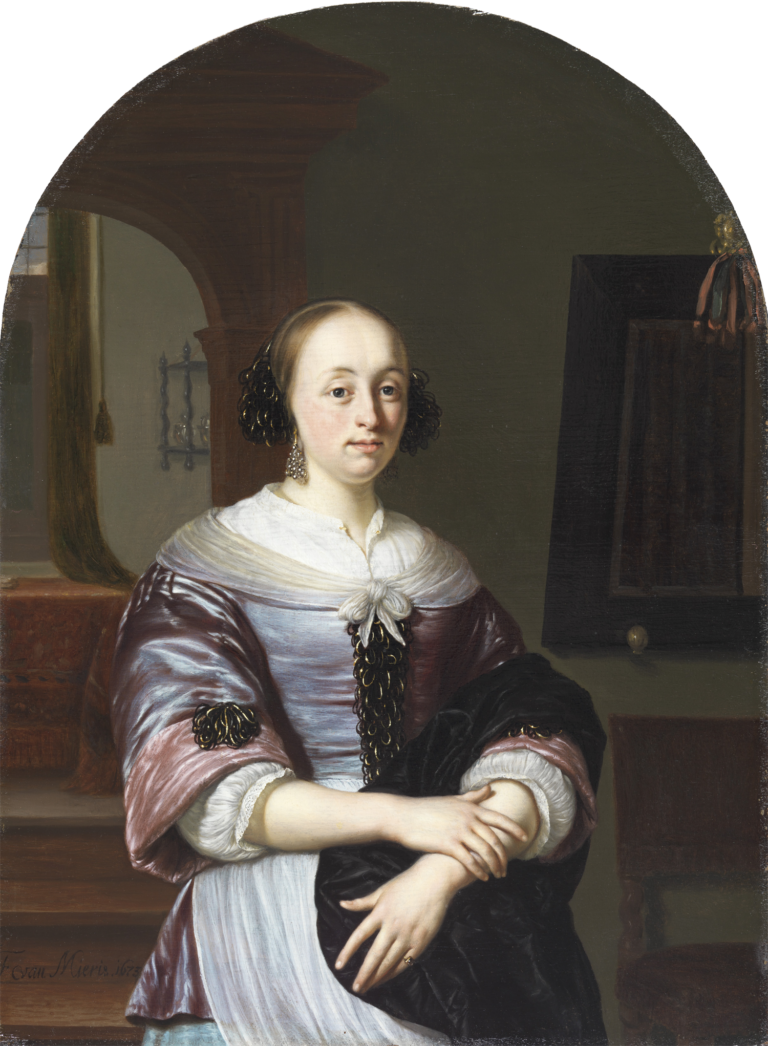The trend toward stylization of Frans van Mieris’s later genre paintings is also apparent in his late portraits, among them this colorful Portrait of a Lady. In this well-preserved panel from 1673, a lady stands in an interior and gazes out at the viewer as she gracefully rests her right hand on her left wrist. She wears large, decorative silver earrings and a ring on the little finger of her left hand. The woman is dressed in the latest fashion, with the gold-thread braiding of her fine satin dress also incorporated into her hair. Her dark velvet shawl helps set off the smooth skin of her pale arms and hands.
The décor of the room is sparse but elegant. Hanging above a chair at the right is a mirror, which appears to show the reflection of a curtain hanging over a window. The simple black frame of the mirror is decorated at the top by a flourish of blue and pink ribbons, and at the bottom we see a small white object. Behind the woman is a small flight of steps, where Van Mieris inscribed his signature and the date of the painting.1 An arched doorway at the top of the landing leads to a room furnished with a table covered by an expensive Persian rug. On the wall of this back room, partly obscured by the doorframe, is a small ornamental rack with twisted upright supports topped by decorative knobs. Two large silver vessels are displayed on its bottom shelf.2
Van Mieris painted this stunning portrait as a pendant to one depicting the woman’s husband.3 The signature on this pendant is incorporated in a rather conspicuous manner, as Van Mieris added the monogram “FvM” to the piece of paper in the man’s hands but left out the date altogether (fig 1). A wooden sphere on the handrail on which the man’s elbow rests probably denotes the virtuousness of the sitter, who is shown in a fairly relaxed pose as he gazes toward his wife.4 His jacket with the large red obi is a so-called Japonsche rock, which was worn only inside the house. Like his fancy collar, it was the height of contemporary fashion and very expensive, demonstrating both his wealth and cultured demeanor.
In many seventeenth-century portraits of couples, the man is depicted on the left side of the painting and the woman on the right, in accordance with heraldic tradition,5 but Van Mieris did not follow this custom with these pendants. As in his pendant portraits from 1669 (FM-110.a and 110.b), Van Mieris linked the two works together through the man’s gaze, which is directed at his wife.6 He also mirrored compositional elements within the arch-shaped panels, including a staircase into a back room and a large black frame hanging near the sitter.
Although the identity of this couple is now unknown, we can glean some information about the sitters from the paintings. The woman’s clothing and precious earrings, which Van Mieris has rendered with such meticulous care, reflect the couple’s prosperity. The black frame in the husband’s portrait contains a map of a fortified city with the inscription “Smyrne,” suggesting that he had trading relations with Smyrna (now called Izmir), the ancient port city of present-day Turkey.7 Unfortunately, provenance information fails to shed any light on the couple’s identity, as by the time these paintings first appeared in the art market the names of the sitters had been lost. In fact, at some point the two paintings actually ended up in different collections. The Amsterdam collector Nicolaas Nieuhoff (1733–76) is the earliest known owner of the woman’s portrait.8 It says a great deal about Van Mieris’s reputation in the eighteenth century that his portrait of a woman fetched 700 guilders at the sale of the Nieuhoff Collection, whereas Vermeer’s now much-loved Woman Holding a Balance (National Gallery of Art, Washington D.C.) was sold for the considerably lesser sum of 235 guilders.9
